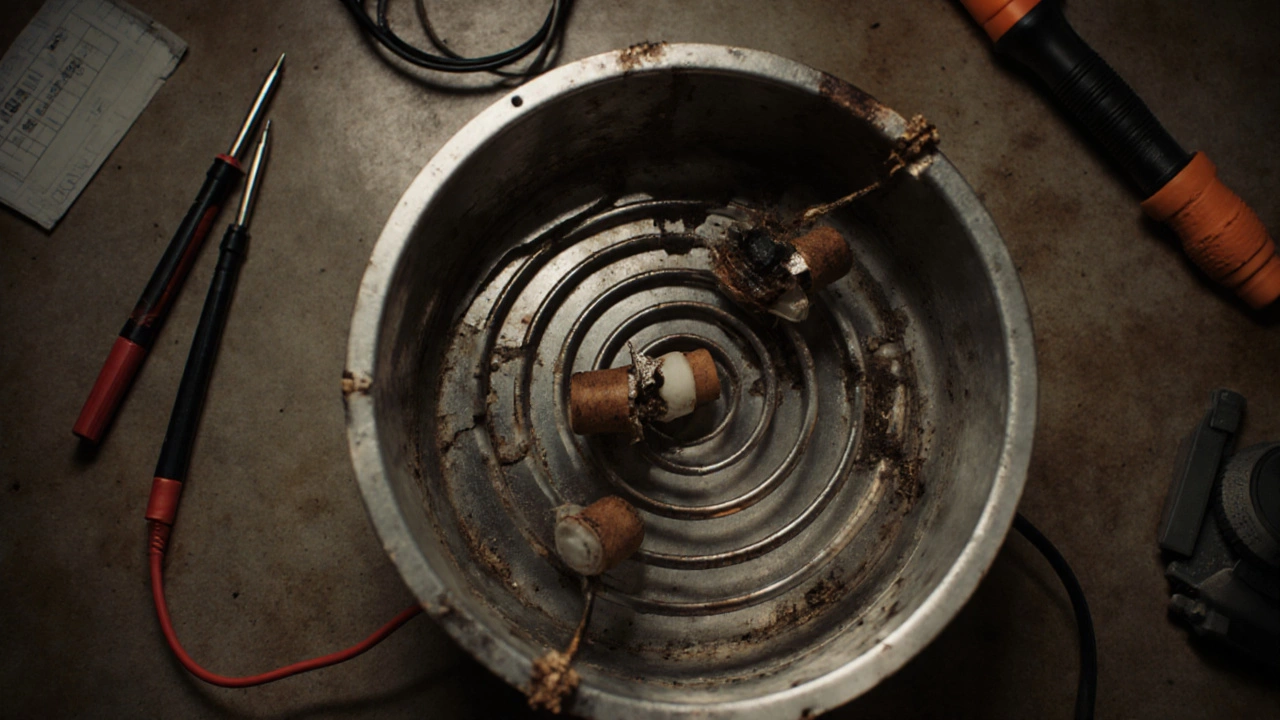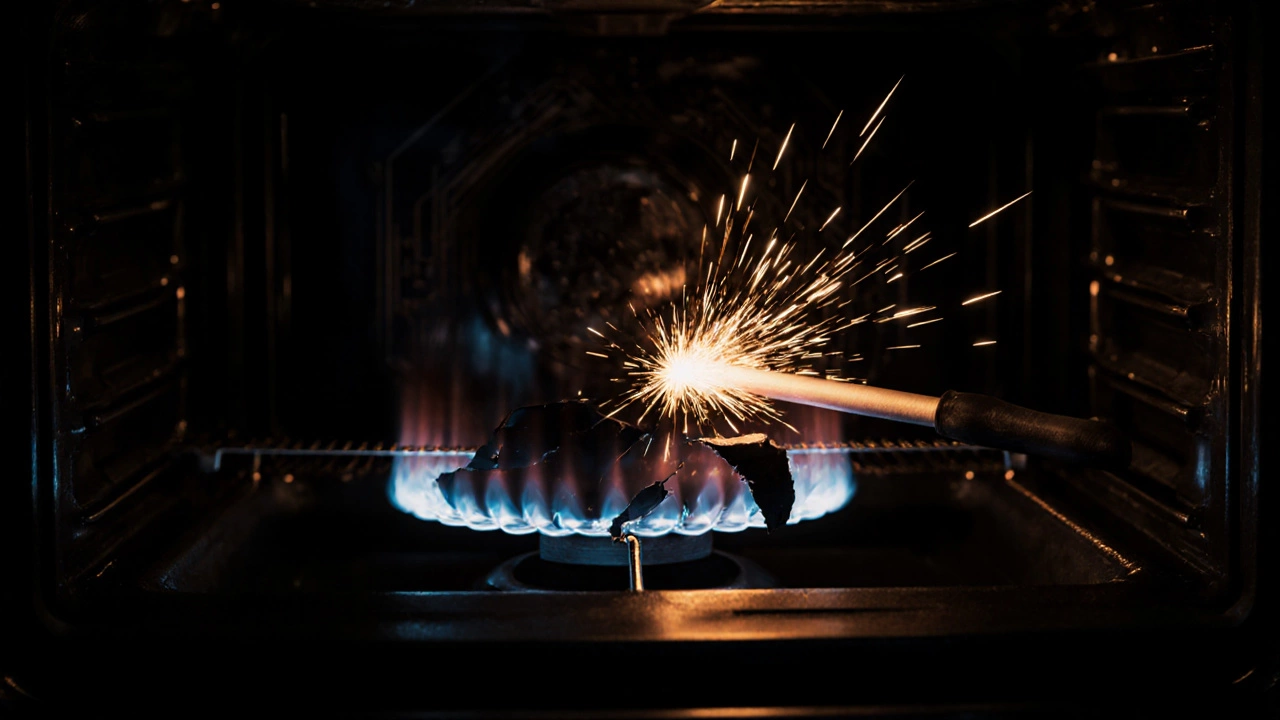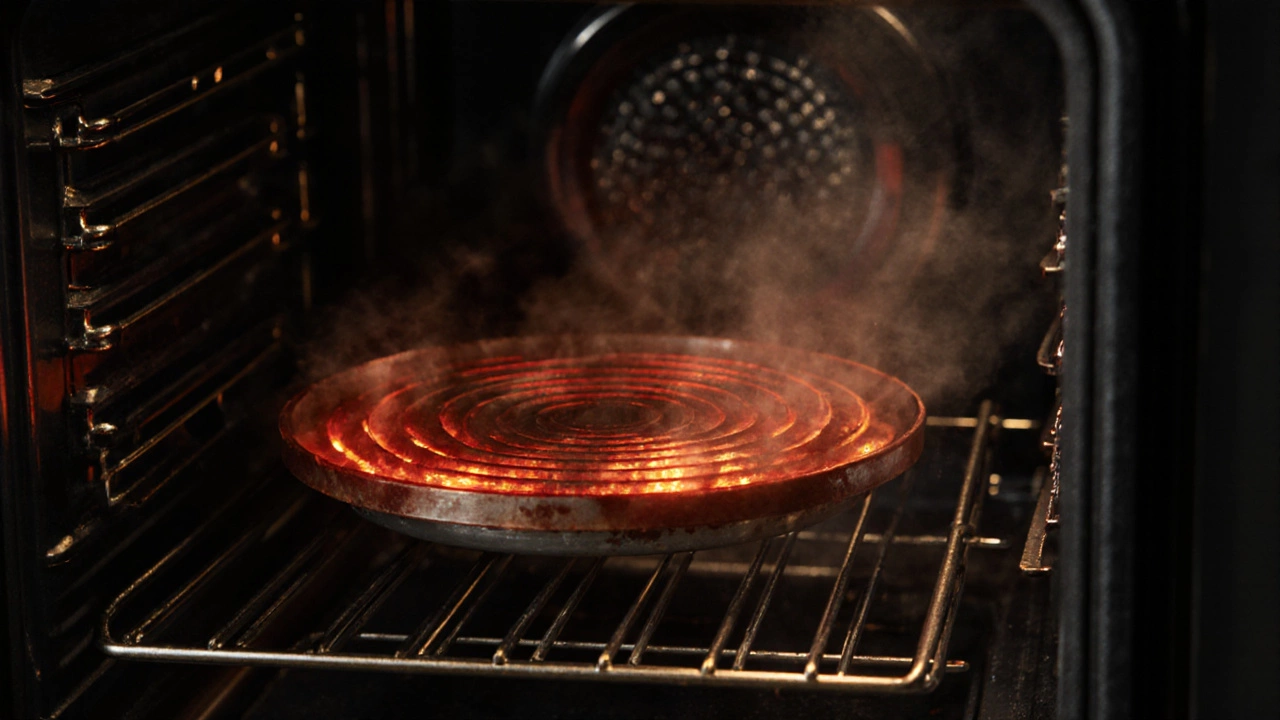If your oven won’t heat up, or only heats unevenly, the most likely culprit is a blown heating element. It’s a common problem-especially in older electric ovens-and fixing it yourself can save you hundreds of dollars. You don’t need to be a technician to spot the signs. Here’s how to know for sure if your oven element is blown, and what to do next.
Look at the element when the oven is on
The simplest way to check is to turn the oven on and watch the element. Set it to bake at 180°C and wait five minutes. Open the door slightly (don’t leave it open too long or the temperature drops). The heating element should glow a bright orange-red all the way across. If you see dark spots, black patches, or sections that stay dull, that’s a clear sign the element is failing. Some parts may have burned out completely, leaving gaps in the glow. A fully blown element won’t glow at all.This isn’t just a visual guess. The heating element is a resistive wire inside a metal sheath. When it breaks, electricity can’t flow through it properly. No current = no heat = no glow. If it’s not glowing like a toaster coil, it’s not working.
Check for visible damage
Turn off the oven and unplug it-or better yet, turn off the circuit breaker. Wait for the oven to cool completely. Open the oven door and pull out the racks. Now look closely at the element. It’s usually at the bottom of the oven (for baking), and sometimes at the top (for broiling).Look for:
- Cracks or splits in the metal sheath
- Bulges or blistering where the element has overheated
- Broken or dangling wires connected to the element
- Charring or burn marks on the ceramic insulators at the ends
If you see any of these, the element is done. Even small cracks can let moisture in or cause arcing, which makes the element fail faster. A broken wire means the circuit is open. No circuit = no heat.
Listen for unusual sounds
A working element is quiet. If you hear popping, crackling, or buzzing when the oven turns on, that’s a red flag. These sounds often come from electrical arcing inside a damaged element. The electricity is jumping across gaps instead of flowing smoothly. That’s dangerous-it can cause a short circuit or even start a fire. If you hear these noises, stop using the oven immediately.Some people mistake a faulty thermostat for a bad element. But a thermostat doesn’t make noise. If the oven turns on and you hear popping, it’s the element.

Test with a multimeter
If you’re still unsure, grab a multimeter. It’s a $20 tool you can buy at any hardware store. You’ll need to disconnect the oven from power and remove the element to test it properly.Here’s how:
- Turn off the circuit breaker for the oven.
- Remove the oven racks and any panels covering the element (usually held by two screws).
- Unplug the two wires connected to the element. Take a photo first so you know where they go.
- Set your multimeter to ohms (Ω), usually the 200Ω setting.
- Touch one probe to each terminal on the element.
If the multimeter reads between 20 and 120 ohms, the element is fine. That’s normal resistance for a working oven element. If it reads OL (open loop) or no reading at all, the element is blown. Some elements may read 0 ohms-that’s also bad. It means there’s a short inside, not an open circuit. Either way, it needs replacing.
Don’t skip this step if you’re unsure. A multimeter gives you proof. No guesswork.
Other signs your oven element is dead
Beyond the glow, damage, and sound, watch for these clues:- The oven takes way longer than usual to heat up-even if the light comes on.
- Only one side of the oven heats up. Food cooks unevenly. That’s often because one element (top or bottom) is dead.
- The oven light works, but nothing heats. That rules out a power issue.
- The oven displays an error code like “E1” or “F3.” Check your manual. Many brands use these codes to signal element failure.
Some newer ovens have self-diagnostic modes. If yours does, run the diagnostic. It’ll tell you if the element circuit is open. That’s a direct confirmation.

What’s not the problem
Before you replace the element, rule out other issues:- Thermostat: If the oven heats up but doesn’t stop, or doesn’t reach the right temperature, it could be the thermostat. But if it doesn’t heat at all, it’s usually the element.
- Thermal fuse: Some ovens have a fuse that blows if they overheat. If the oven is completely dead-no light, no fan, no heat-it might be the fuse. But if the light and fan work, it’s not the fuse.
- Control board: Rare. If multiple functions (bake, broil, convection) fail at once, it might be the board. But if only bake mode is dead, it’s the element.
Most of the time, if the oven light works but the bottom element doesn’t glow, you’ve got a blown element. It’s the #1 fix for this problem.
What to do if it’s blown
Replace it. It’s not hard. You can buy a replacement element online for $30-$80, depending on your oven model. Use the model number (usually on a sticker inside the door or on the back) to find the right part.Installation takes 20 minutes. Just:
- Turn off the power.
- Remove the old element (unscrew it, unplug the wires).
- Plug the new one in and screw it in place.
- Turn the power back on and test.
No soldering. No wiring. No special tools. Just basic screwdriver skills.
If you’re not comfortable doing it yourself, hire a repair technician. But don’t pay $150 to replace a $40 part. You can do it.
How long do oven elements last?
Most oven elements last 5-10 years. In homes with heavy use-like in Wellington where people bake often during winter-they can wear out faster. Moisture, frequent cleaning, and power surges shorten their life. If your oven is over 8 years old and the element has failed, it’s not unusual. It’s just part of the lifecycle.Replacing the element is cheaper than buying a new oven. And it’s better for the planet. Don’t toss it. Fix it.
Can I still use my oven if one element is blown?
You shouldn’t. If the bake element is blown, your oven can’t bake properly. If the broil element is dead, you can’t broil. Using it might cause uneven cooking or strain other parts. Worst case, a damaged element can arc and create a fire risk. Turn it off and replace it.
Why does my oven element glow unevenly?
Uneven glowing means the resistive wire inside has broken in spots. Electricity flows only where the wire is intact, so only those sections heat up. This is a sign of wear or overheating. It’s not safe to continue using it-replace the element.
How do I find the right replacement element?
Look for your oven’s model number, usually on a sticker inside the door frame or on the back panel. Search online using that number plus "heating element" or "bake element." Make sure the shape, length, and terminal positions match your old one. Don’t guess-exact matches matter.
Can a power surge blow an oven element?
Yes. Power surges can overload the element’s wire, causing it to melt or break. If you’ve had a recent storm or power flicker right before the oven stopped working, that’s likely why. Installing a surge protector for major appliances can help prevent this.
Is it worth repairing an old oven?
If your oven is under 10 years old and the rest of it works well, yes. Replacing the element costs less than 10% of a new oven. If it’s older than 15 years and you’re already replacing parts, it might be time to upgrade. But for most people, a new element is the smart, economical choice.

